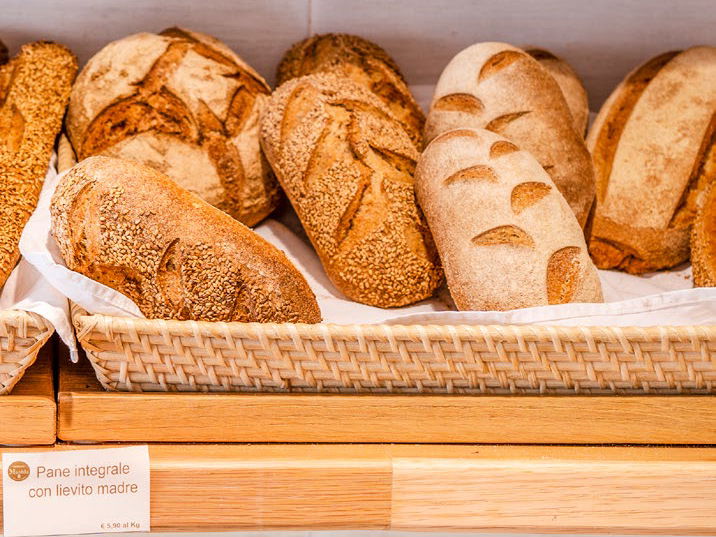Pane Siciliano al Sesamo
Pane Siciliano al Sesamo
Sesame Seed Loaf
Lots of Italian bakeries in the US sell loaves that don’t quite taste the way they do in the motherland. This sesame-crusted loaf is an exception, though: I actually grew up eating a version in New Jersey that is similar to the Sicilan original. My Grandma Parla used to send me down the street from her house in North Brunswick to the long since closed Mento’s Market, a small grocery owned by Sicilians, for a loaf of bread and a pack of cigarettes (the 1980s were a simpler time). When I visited Sicily, I found a slightly shorter but identical-tasting sesame loaf in bakeries across the island, where it’s sliced into rounds and served alongside meals for soaking up sauce.
Ingredients (8)
Ingredients (8)
Instructions
Combine the room-temperature water (1 ½ cups), bread flour (3 ¼ cups), and fine semolina (¾ cup) in a medium bowl and mix with a spoon until the dough is shaggy and there is no dry flour left in the bowl, about 5 minutes.
Cover with plastic wrap and let stand at room temperature for 20 minutes to allow the flour to hydrate.
Meanwhile, combine the warm water (1 ¼ Tbsp) and yeast (1 ¼ tsp) in a small bowl or ramekin and set aside to bloom for about 10 minutes.
Uncover the bowl and add the yeast mixture, “pinching” it into the dough with your fingers until it is incorporated, about 2 minutes. The dough will be very sticky, but don’t add more flour.
Sprinkle the salt (2 tsp) over the dough and “pinch” and fold it in, lifting and folding the dough to aid the process, until incorporated, about 2 minutes. The dough will be very sticky again, but don’t add more flour.
Cover with plastic wrap and set aside at room temperature for 15 minutes to allow the yeast to proliferate.
Uncover the bowl. Wet one hand, then lightly grasp one edge of the dough. Pull this flap of dough upward and outward, then bring it back down and attach it to the top of the dough. Give the bowl a one-eighth turn and repeat seven more times, until you have rotated the bowl a complete turn.
Cover the bowl with plastic wrap and let the dough rest for 15 minutes more.
Repeat the folding and turning process, rest for 15 minutes, then fold and turn one more time.
Cover the bowl with plastic wrap and set aside for 1 hour. The dough will spread out in the bowl, growing by about 25 percent and becoming slightly puffy.
Invert the bowl over a lightly floured surface, allowing the dough to gently detach itself from the bowl. Using a dough scraper or sharp knife, cut the dough into two equal pieces.
Working with one piece at a time, gently coax the dough into a rectangle measuring about 4 by 6 inches. Position the rectangle with one long edge closest to you, then fold the top third down toward the middle. Fold the bottom third up to meet the top edge of the dough. Fold the left third of the dough toward the middle, then fold the right third over to meet the far edge. Cover with a clean kitchen towel and repeat with the remaining dough.
Let rest, covered, for 20 minutes. If your climate is very dry, dampen the towel and fully wring it out before covering the dough.
Lightly flour your work surface again, if needed, then uncover the dough and position it horizontally, seam-side up. Take the top corners and fold them inward 1 to 1½ inches. Take the top flap and fold it over the dough 2 inches, gently pressing down and away from you to attach it, taking care not to deflate the dough. Repeat the top-flap folding twice more to form a medium-tight tube. Holding your hands flat, gently roll the dough back and forth, elongating the tube and tapering it by applying a little more pressure toward the ends. Roll until the dough is 13 to 14 inches long, then set aside and cover the dough with a clean kitchen towel. Repeat with the second piece of dough.
Line an inverted baking sheet with parchment paper and dust with fine semolina. Dampen a paper towel and place it on a flat surface. Distribute the sesame seeds (¼ cup) over a piece of parchment or aluminum foil in a strip about as long as your loaves.
Working with one piece of dough at a time, and keeping track of the seam, roll the dough first over the paper towel, evenly moistening the entire surface, then roll it in sesame seeds, coating the entire exterior. Transfer the sesame-coated dough to the prepared baking sheet, seam-side down. Repeat with the second piece of dough.
Cover with a clean kitchen towel and set aside at room temperature until the loaves have roughly doubled in size, 1 to 1½ hours.
Preheat the oven to 475°F and set a baking steel or stone on the center rack to preheat as well. Place an empty ovenproof pot or pan at the bottom of the oven.
To test the dough’s readiness, gently poke it with your finger about ¼ inch deep. If no impression is left and the dough completely springs back, it needs more time to proof. If the dough springs back 75 percent of the way, it’s ready to bake.
Uncover the loaves and score them. Transfer the loaves on the parchment to the baking steel and pour 2 cups hot water into the pot or pan below, closing the oven quickly to trap the steam.
As the bread rises in the oven, scoring encourages it to expand in a controlled way. To score the dough, use a baker’s lame (pronounced lahm) or a clean razor blade to make three evenly spaced diagonal incisions, 3 inches long and 1/8 inch deep, in the top of the loaf, beginning 2 inches from the center top of the loaf’s short end.
Bake for 15 minutes.
Rotate the loaves a half turn and bake until golden brown all over, about 5 minutes more.
Remove from the oven and let cool completely on a wire rack before slicing or storing.
The cooled bread will keep wrapped in plastic wrap at room temperature, for up to 4 days.

